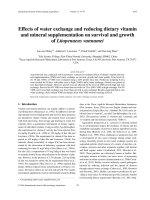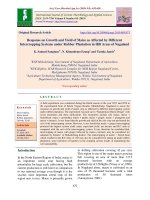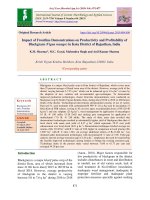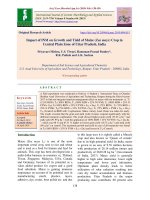Studies on skewness and Kurtosis of sorghum downy mildew resistant BC3F3 progenies in maize
Bạn đang xem bản rút gọn của tài liệu. Xem và tải ngay bản đầy đủ của tài liệu tại đây (161.32 KB, 5 trang )
Int.J.Curr.Microbiol.App.Sci (2018) 7(6): 3834-3838
International Journal of Current Microbiology and Applied Sciences
ISSN: 2319-7706 Volume 7 Number 06 (2018)
Journal homepage:
Original Research Article
/>
Studies on Skewness and Kurtosis of Sorghum
Downy Mildew Resistant BC3F3 Progenies in Maize
K. Sumathi1*, K.N. Ganesan2 and N. Senthil3
1
Centre for Plant breeding and Genetics, TNAU, Coimbatore, India
2
Millet Breeding Station, TNAU Coimbatore, India
3
Centre for Plant Molecular Biology, TNAU Coimbatore, India
*Corresponding author
ABSTRACT
Keywords
Skewness,
Kurtosis,
Maize
Article Info
Accepted:
25 May 2018
Available Online:
10 June 2018
The present investigation was carried out at Eastern Block of the Central Farm Unit,
Department of Agronomy, Tamil Nadu Agricultural University, Coimbatore, Tamil Nadu,
India to identify the gene interaction for yield contributing characters to increase the yield.
For this purpose nine biometrical characters of four SDM resistant progenies viz., UMI
79/936-C1- 7-7-7-40, UMI 79/936-C1- 7-7-7-46, UMI 79/936-C1- 7-7-7-52 and UMI
79/936-C1- 7-7-7-80 were used for skewness and kurtosis studies. These studies revealed
that in BC3F3 population, progeny UMI 79/936- C1-7-7-7-40 positive skewness for days
to 50% tasseling, days to 50% silking, days to maturity, cob diameter, 100 grain weight
and grain yield per plant and negative kurtosis was observed for the traits under study. The
positive skewness indicates the presence of complementary epistatic gene action for the
trait and the gain is slower with mild selection and gain is faster with intensive selection.
The progenies UMI 79/936- C1-7-7-7-46, UMI 79/936- C1-7-7-7-52 and UMI 79/936C1-7-7-7-80 showed positive skewness for 50% tasseling, days to 50% silking, days to
maturity, cob length, cob diameter, 100 grain weight and grain yield per plant. Most of the
traits under study showed negative kurtosis in BC3F3 population. The negative kurtosis
indicate platykurtic curve which means that flat values are present in the distribution and
complementary gene action. If selection for these characters were made intensively, the
gain will be faster.
Introduction
Maize is an important cereal in many
developed and developing countries of the
world. In terms of breeding, it is one of the
most studied species and has been used as a
model in many situations. It is widely used for
animal feed and industrial raw material in the
developed countries where as the developing
countries use it in general for feed. Globally, it
is known as queen of cereals because it has the
highest genetic yield potential among the
cereals. Plant breeders are interested in
developing cultivars resistant to pest and
disease with improved yield and other
phenological characters. In order to achieve
this goal, the breeders had the option of
selecting desirable genotype in early
3834
Int.J.Curr.Microbiol.App.Sci (2018) 7(6): 3834-3838
generations or delaying intense selection until
advanced generations. Downy mildews are
important maize diseases in many tropical
regions of the world. They are particularly
destructive in many regions of tropical Asia
where losses in excess of 70% have been
documented. Globally, downy mildew
affected areas with significant economic
losses are reported to be as high as 30%
(Jeffers et al., 2000).
Skewness helps us to draw the conclusion
about the gene action for a particular trait. The
positive skewness indicates the presence of
complementary epistatic gene action for the
trait and the gain is slower with mild selection
and gain is faster with intensive selection. The
negative skewness indicates the presence of
duplicate epistasis gene action and the gain is
faster with mild selection and rapid with
intense selection (Snape and Riggs, 1975).
Kurtosis will occur if either a few genes are
controlling the phenotypic distribution or there
are inequalities in the additive genetic effects
at different loci. Traits for which data showing
leptokurtic distribution are usually those under
control of relatively few segregating genes,
whereas data showing a platykurtic
distribution usually represent characters that
are controlled by many genes. The positive
values of kurtosis indicate leptokurtic curve
while negative kurtosis indicate platykurtic
curve and if values are zero, it indicates
mesokurtic i.e. normal distribution. The
platykurtic and leptokurtic nature indicates the
wider and narrow variability of the population
respectively. The platykurtic nature of the
population will help in the selection
programme due to wider variability in that
population for the specific character.
of Agronomy, Tamil Nadu Agricultural
University, Coimbatore, Tamil Nadu, India
during Rabi 2014. BC3F3 population was used
in the present study. It is derived from
crossing the inbred UMI 79 which is
susceptible for sorghum downy mildew and
UMI 936(w) which has resistance for sorghum
downy mildew and backcrossing progenies
with UMI79. Two selfing was carried out to
generate the population of BC3F2 and BC3F3.
Four SDM resistant progenies viz., UMI
79/936-C1- 7-7-7-40, UMI 79/936-C1- 7-7-746, UMI 79/936-C1- 7-7-7-52 and UMI
79/936-C1- 7-7-7-80 were used for skewness
and kurtosis studies.
In these four progenies the data on nine
quantitative characters viz., days to 50%
tasseling, days to 50% silking, plant height,
Ear height, Days to maturity, Cob length, Cob
diameter, Yield per plant and 100 grain weight
were recorded.
Frequency distribution
The phenotypic data of BC3F3 along with the
parents were utilized for studying the
frequency distribution in days to 50%
tasseling, days to 50% silking, plant height,
Ear height, Days to maturity, Cob length, Cob
diameter, Yield per plant and 100 grain weight
to know about the extremes in the population.
It was calculated by taking minimum and
maximum value of the trait. Then the
difference between the maximum and
minimum values is recorded as ‘X’ and the
class interval is fixed as 10. Then the bin
range was fixed by dividing the value ‘X’ with
class interval. With the bin range, the
frequency of population is obtained.
Skewness and Kurtosis were calculated using
the frequency distribution (Kapur, 1980) of
the characters mentioned.
Materials and Methods
The experiments were conducted in Eastern
Block of the Central Farm Unit, Department
β1
3835
= Skewness
Int.J.Curr.Microbiol.App.Sci (2018) 7(6): 3834-3838
If,
β1 > 0, then positively skewed
β1< 0, then negatively skewed
β1= 0, then symmetric distribution
β2= Kurtosis
If,
β2
β2
β2
>
<
=
and gain is faster with intensive selection. The
negative skewness indicates the presence of
duplicate epistasis gene action and the gain is
faster with mild selection and rapid with
intense selection (Snape and Riggs, 1975).
1, then leptokurtic
1, then platykurtic
0, then mesokurtic
The positive values of kurtosis indicate
leptokurtic curve while negative kurtosis
indicate platykurtic curve and if values are
zero, it indicates mesokurtic i.e. normal
distribution. The platykurtic and leptokurtic
nature indicates the wider and narrow
variability of the population respectively. The
platykurtic nature of the population will help
in the selection programme due to wider
variability in that population for the specific
character.
Where,
Where,
Xi is the individual observation
X is the mean of the character under
observation and
N is the number of observations
Significance
The skewness and kurtosis was divided by the
respective standard errors to calculate t value.
The calculated‘t’ value was compared with ‘t’
table value with (n-1) degrees of freedom to
assess significance.
6
SEβ1 = N
SEβ2 =
24
N
Frequency distribution indicated that all the
progenies showed positive skewness for the
characters days to 50% tasseling, days to 50%
silking, days to maturity, cob diameter and
yield per plant. The traits viz., days to 50%
tasseling and days to 50 % silking ranged from
0.23 (UMI 79/936-C1-7-7-7-40) to 0.75 (UMI
79/936-C1-7-7-7-52) and 0.35 (UMI 79/936C1-7-7-7-40) to 1.41 (UMI 79/936-C1-7-7-752) respectively. Days to maturity ranged
from 0.38 (UMI 79/936-C1-7-7-7-46) to1.41
(UMI 79/936-C1-7-7-7-52).Cob diameter and
yield per plant ranged from 0.21 (UMI
79/936-C1-7-7-7-52) to 1.28 (UMI 79/936C1-7-7-7-46), 0.05 (UMI 79/936-C1-7-7-740) to 0.28(UMI 79/936-C1-7-7-7-46)
respectively (Table 37).
The progeny (UMI 79/936-C1-7-7-7-40)
exhibited negative skewness for the characters
plant height, ear height and cob length.
Results and Discussion
Skewness helps us to draw the conclusion
about the gene action for a particular trait. The
positive skewness indicates the presence of
complementary epistatic gene action for the
trait and the gain is slower with mild selection
All the progenies showed negative skewness
for plant height and ear height, it ranged from
-1.50 (UMI 79/936-C1-7-7-S7-S46) to -0.02
(UMI 79/936-C1-7-7-7-40) and -0.66 (UMI
79/936-C1-7-7-7-52) to -0.27 (UMI 79/936C1-7-7-7-40) respectively.
3836
Int.J.Curr.Microbiol.App.Sci (2018) 7(6): 3834-3838
Table.1 Skewness and Kurtosis observed in the SDM resistant progenies of BC3F3 generation
TRAITS
Days to 50 per cent
tasseling
Days to 50 per cent silking
Plant height (cm)
Ear height (cm)
Days to maturity
Cob length (cm)
Cob diameter (cm)
100 Grain weight (g)
Yield per plant (g)
79/936-C1-7-7-S7-S40
79/936-C1-7-7-S7-S46
79/936-C1-7-7-S7-S52
79/936-C1-7-7-S7-S80
Skewness
Kurtosis
Skewness
Kurtosis
Skewness
Kurtosis
Skewness
Kurtosis
0.23
-0.97
0.38
-1.48
0.75
0.34
0.37
-3.90
0.35
-0.02
-0.66
0.53
-0.20
0.74
0.08
0.05
-1.06
-1.71
-0.57
-1.24
-0.52
1.09
-1.80
-1.28
0.42
-1.50
0.32
0.38
0.33
1.28
1.09
0.28
-0.86
2.61
-1.80
-1.48
-0.66
1.67
0.07
-2.09
1.41
-0.33
-0.27
1.41
0.10
0.21
-0.05
0.09
1.50
-2.01
-3.50
1.50
-1.03
1.12
-0.68
-4.66
0.75
-0.88
-0.60
1.12
0.55
1.27
0.13
0.25
0.34
1.45
-0.95
1.46
-1.65
1.27
-0.62
-1.47
3837
Int.J.Curr.Microbiol.App.Sci (2018) 7(6): 3834-3838
Three progenies namely UMI 79/936-C1-7-77-46, UMI 79/936-C1-7-7-7-46 and UMI
79/936-C1-7-7-7-46
showed
positive
skewness for cob length. The progeny UMI
79/936-C1-7-7-7-40 (-0.52) showed negative
skewness for cob length. For 100 grain weight
except the progeny (UMI 79/936-C1-7-7-752) all other progenies showed positive
skewness ranged from 0.13 (UMI 79/936-C17-7-7-80) to 1.09 (UMI 79/936-C1-7-7-7-46).
One progeny UMI 79/936-C1-7-7-7-46 (0.07)
showed positive kurtosis for 100 grain weight
and remaining three progenies showed
negative kurtosis ranged from -1.80 (UMI
79/936-C1-7-7-7-40) -0.62 (UMI 79/936-C17-7-7-80). All the progenies showed positive
skewness and negative kurtosis for yield per
plant range from 0.05 (UMI 79/936-C1-7-7-740) to 0.28 (UMI 79/936-C1-7-7-7-46) and 4.66 (UMI 79/936-C1-7-7-7-80) to -1.28
(UMI 79/936-C1-7-7-7-46) respectively.
To conclude that in BC3F3 population,
progeny UMI 79/936- C1-7-7-7-40 positive
skewness for days to 50% tasseling, days to
50% silking, days to maturity, cob diameter,
100 grain weight and grain yield per plant and
negative kurtosis was observed for the traits
under study. The positive skewness indicates
the presence of complementary epistatic gene
action for the trait and the gain is slower with
mild selection and gain is faster with intensive
selection. The progenies UMI 79/936- C1-77-7-46, UMI 79/936- C1-7-7-7-52 and UMI
79/936- C1-7-7-7-80 showed positive
skewness for 50% tasseling, days to 50%
silking, days to maturity, cob length, cob
diameter, 100 grain weight and grain yield per
plant. Most of the traits under study showed
negative kurtosis in BC3F3 population. The
negative kurtosis indicate platykurtic curve
which means that flat values are present in the
distribution and complementary gene action.
If selection for these characters were made
intensively, the gain will be faster. This result
is in corroboration with the findings of
Tamilkumar (2012) and Aarthi (2012) for
grain yield per plant.
References
Jeffers, D., H. Cordova, S. Vasal, G. Srinivasan,
D. Beck and M. Barandiaran. 2000. Status
in breeding for resistance to maize
diseases at CIMMYT. In: Vasal SK,
Gonzalez Ceniceros F, Fan XM (Eds.).
Proc. 7th Asian Regional Maize
Workshop.
PCARRD,
Los
Baos,
Philippines, pp. 257–266.
Kapur, S. K. 1980. Elements of Practical
Statistics. Oxford and IBH Publishing
Co., New Delhi. pp. 148 - 154.
Snape, J. W and T. S. Riggs. 1975. Genetical
consequences of single seed descent in the
breeding of self pollinated crops.
Heredity, 35: 211 - 219.
Sruthy Menon, V. 2014. Studies on phenotyping
of BC3F2 population and molecular
characterisation of elite BC3F3 progenies
for sorghum downy mildew resistance in
maize (Zea mays L.). M.SC. thesis
submitted to Tamil Nadu Agricultural
University.
Suresh Kumar, S. 2014. Development of low
phytate maize through marker assisted
selection. Ph. D. thesis submitted to Tamil
Nadu Agricultural University.
How to cite this article:
Sumathi, K., K.N. Ganesan and Senthil, N. 2018. Studies on Skewness and Kurtosis of
Sorghum Downy Mildew Resistant BC3F3 Progenies in Maize. Int.J.Curr.Microbiol.App.Sci.
7(06): 3834-3838. doi: />
3838









